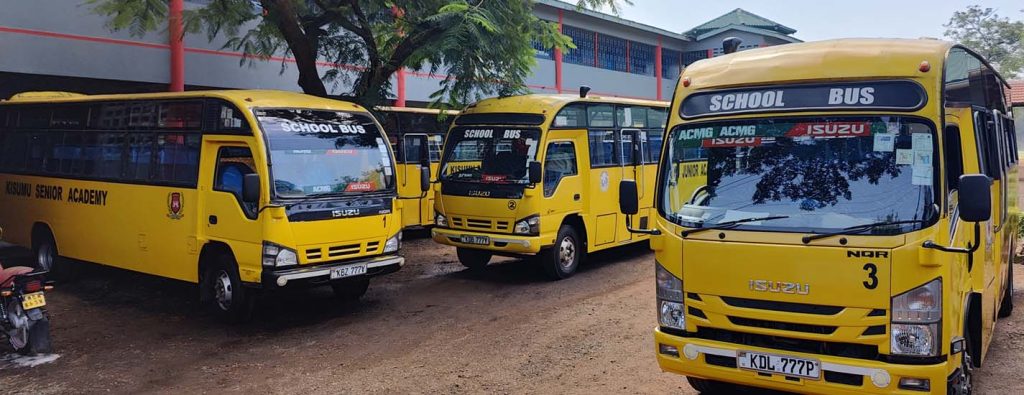In Kenya, ensuring the safety of schoolchildren during their daily commute is a top priority for parents, schools, and transport authorities. With the rising number of students relying on school buses, the role of a school bus conductor—also referred to as a school vehicle attendant—has become increasingly critical. The National Transport and Safety Authority (NTSA) has introduced stringent regulations under the Draft Traffic (School Transport) Rules 2025 to enhance child safety and regulate school transport operations. These rules outline specific requirements for school bus conductors, emphasizing qualifications, licensing, and criminal record assessments to protect students. This article provides a comprehensive guide to the requirements for becoming a school bus conductor in Kenya, the role’s responsibilities, and the broader context of Kenyan transport regulations in 2025.
Why School Bus Conductors Are Vital in Kenya
School bus conductors play an indispensable role in ensuring the safety, discipline, and well-being of students during transit. Unlike regular public service vehicle (PSV) conductors, school vehicle attendants are tasked with specialized duties that prioritize child safety. With Kenya’s growing focus on road safety, the NTSA has implemented measures to ensure that only qualified individuals serve in this capacity. The Draft Traffic (School Transport) Rules 2025 introduced mandatory qualifications and annual assessments to safeguard children, addressing concerns about child abuse, violence, and negligence in school transport systems.
The importance of these regulations cannot be overstated. According to NTSA, school transport vehicles are subject to rigorous safety checks, and the presence of a qualified school bus conductor is non-negotiable. This ensures that children are not only transported safely but also supervised effectively during their journeys. For parents and schools, understanding these requirements is essential to ensure compliance and prioritize student welfare.
Key Requirements for a School Bus Conductor in Kenya
To serve as a school bus conductor in Kenya, individuals must meet specific criteria outlined by the NTSA. These requirements are designed to ensure that attendants are competent, trustworthy, and capable of handling the responsibilities associated with transporting children. Below are the key requirements for a school vehicle attendant in 2025:
1. Valid PSV Conductor License
- Mandatory Licensing: Every school bus conductor must hold a valid Public Service Vehicle (PSV) conductor license issued by the NTSA. This license ensures that the attendant is trained in the basics of passenger management and road safety.
- Application Process: To obtain a PSV conductor license, applicants must:
- Be at least 18 years old and a Kenyan citizen.
- Register on the NTSA’s Transport Integrated Management System (TIMS) portal.
- Submit a valid identification document, a clear passport photo, and a certificate of good conduct from the Directorate of Criminal Investigations (DCI).
- Pay a fee of Ksh 1,050 (Ksh 1,000 for the badge and Ksh 50 for convenience charges).
- Verification: Transport providers can verify the status of a conductor’s license using the NTSA’s online license check tool to ensure compliance.
2. Annual Criminal Record Assessment
- Mandatory Background Checks: School bus conductors must undergo and pass an annual criminal record assessment. This process screens for convictions related to child abuse or incidents of arrests for violence.
- Disqualification Criteria: A school vehicle attendant with a criminal record containing convictions for child abuse or arrests for violent behavior is strictly disqualified from serving in this role. This measure prioritizes child safety and public confidence in school transport systems.
- Obtaining a Certificate of Good Conduct: Applicants must obtain a certificate of good conduct from the DCI, which confirms the absence of a disqualifying criminal record. This certificate is a prerequisite for the PSV conductor license application.
3. Compliance with NTSA Regulations
- Training and Certification: While not explicitly mandated, many school bus conductors undergo specialized training to handle emergencies, manage student behavior, and assist children with disabilities. This training is often provided by recognized driving schools or transport organizations.
- Renewal Requirements: The PSV conductor badge is valid for two years and must be renewed at least one month before expiration. Renewal may require updated documentation, including a new certificate of good conduct.
The Role of a School Bus Conductor: Responsibilities and Duties
The Draft Traffic (School Transport) Rules 2025 clearly define the responsibilities of a school bus conductor, emphasizing their role in ensuring student safety and maintaining order during transit. Below is a detailed breakdown of the duties assigned to school vehicle attendants:
- Assisting with Boarding and Disembarking: Conductors must help students board and disembark safely, ensuring that children clear a safe distance from the vehicle after getting off. This is critical in preventing accidents, especially at busy school gates or road crossings.
- Ensuring Proper Securing of Students and Equipment: Attendants are responsible for ensuring that students and their belongings are securely positioned to prevent injuries during transit.
- Monitoring Student Safety: Conductors must continuously monitor the safety of students and equipment, addressing any potential risks during the journey.
- Maintaining Discipline: Attendants ensure that all students remain seated while the vehicle is in motion and report any behavioral issues according to established procedures.
- Assisting the Driver: Conductors act as lookouts during unusual traffic conditions, assist with backing the vehicle, and help keep the bus interior clean. They also support the driver in conducting post-trip inspections to ensure no student is left on board.
- Supporting Students with Disabilities: School bus conductors provide special assistance to students with disabilities, ensuring their safety and comfort during transit.
- Facilitating Safe Road Crossings: Attendants are responsible for helping students cross roads safely, particularly at designated pedestrian crossings or school entry points.
These duties highlight the multifaceted role of a school bus conductor, requiring both vigilance and compassion to ensure a safe and orderly environment for students.
Kenyan Transport Regulations 2025: A Broader Context
The Draft Traffic (School Transport) Rules 2025 are part of a broader effort by the NTSA to enhance road safety across Kenya, particularly for school transport. These regulations address not only the qualifications of school bus conductors but also the standards for school buses and drivers. Below are key aspects of the 2025 regulations that impact school transport:
School Bus Requirements
- Signage and Markings: All school buses must display “SCHOOL BUS” on the front and rear, along with the phrase “DO NOT PASS WHEN RED LIGHTS ARE FLASHING” in black block letters at least eight inches high. A complaints phone number must also be visible for reporting reckless driving.
- Safety Features: School buses must be painted yellow (color code FFD800), equipped with functional seat belts designed for children, dual red-light indicators, stop signal arms, and a fire extinguisher. They must also have a vehicular telematics system approved by the Kenya Bureau of Standards (KEBS).
- Operational Guidelines: School buses are restricted to operating between 5 a.m. and 10 p.m., must not exceed 80 km/h, and must allocate a seat for each student, prohibiting standing passengers.
School Bus Driver Requirements
- Licensing and Assessments: Drivers must hold a valid NTSA license for the specific vehicle category, undergo annual criminal record assessments (including checks for child abuse and driving under the influence), and complete annual medical tests.
- Driver Responsibilities: Drivers are responsible for conducting pre-trip and post-trip checks, ensuring the vehicle is clean and secure, and using stop signal arms and red-light indicators when students board or alight.
Compliance and Enforcement
- Road Safety Checks: The NTSA conducts regular compliance checks to ensure school buses meet safety standards, including functional speed limiters, valid inspection certificates, and proper insurance.
- Public Participation: The NTSA has invited public feedback on the Draft Traffic (School Transport) Rules 2025 through forums in counties like Nairobi, Mombasa, and Kisumu, reflecting a commitment to inclusive policymaking.
These regulations underscore Kenya’s dedication to creating a safe and reliable school transport system, with school bus conductors playing a pivotal role.
Challenges and Opportunities for School Bus Conductors
While the NTSA’s regulations aim to enhance safety, they also present challenges and opportunities for school bus conductors and transport providers.
Challenges
- Stringent Requirements: The need for annual criminal record assessments and a valid PSV conductor license can be a barrier for some applicants, particularly those with limited access to resources or documentation.
- Cost of Compliance: The application fee (Ksh 1,050) and costs associated with obtaining a certificate of good conduct may pose financial challenges for low-income individuals seeking to become conductors.
- Training Gaps: While specialized training is beneficial, it is not uniformly available across Kenya, potentially limiting the pool of qualified conductors.
Opportunities
- Job Creation: The mandatory requirement for school bus conductors creates job opportunities for Kenyans, particularly in urban areas with high demand for school transport services.
- Enhanced Professionalism: The licensing and training requirements elevate the role of school bus conductors, fostering a sense of professionalism and accountability.
- Improved Child Safety: By enforcing strict qualifications, the NTSA ensures that school bus conductors contribute to safer journeys for students, building trust among parents and schools.
How to Become a School Bus Conductor in Kenya
For individuals interested in becoming a school bus conductor, the process is straightforward but requires diligence. Below is a step-by-step guide based on NTSA’s requirements:
- Register on the NTSA TIMS Portal:
- Visit the NTSA Citizens Self-Service Portal and create an account using your ID serial number, KRA PIN, and other required details.
- Obtain a Certificate of Good Conduct:
- Apply for a certificate of good conduct through the DCI or the eCitizen portal to confirm a clean criminal record.
- Apply for a PSV Conductor License:
- Log into the TIMS portal, select “Apply for Conductor Badge,” and complete the application form. Upload your ID, passport photo, and certificate of good conduct.
- Pay the Ksh 1,050 fee via mobile banking or bank transfer.
- Await Approval and Collect the Badge:
- After processing (typically same-day), you will receive an SMS notification to collect your PSV conductor badge from an NTSA office.
- Undergo Annual Assessments:
- Schedule and pass annual criminal record assessments to maintain eligibility as a school bus conductor.
The Future of School Transport in Kenya
The Draft Traffic (School Transport) Rules 2025 mark a significant step toward modernizing and securing school transport in Kenya. By prioritizing the qualifications of school bus conductors and enforcing strict safety standards, the NTSA is aligning with global best practices in school transportation. However, the success of these regulations depends on effective implementation, public awareness, and cooperation from schools, transport providers, and communities.
For parents, the assurance that school bus conductors are licensed and vetted provides peace of mind. For schools, compliance with these regulations enhances their reputation and ensures student safety. For conductors, the role offers an opportunity to contribute meaningfully to society while adhering to professional standards.
Becoming a school bus conductor in Kenya in 2025 is more than just a job—it’s a responsibility that demands dedication, vigilance, and a commitment to child safety. The NTSA’s Draft Traffic (School Transport) Rules 2025 set a high standard for school vehicle attendants, requiring a valid PSV conductor license, annual criminal record assessments, and a clear record free of child abuse or violent convictions. By fulfilling these requirements and embracing their duties, school bus conductors play a critical role in ensuring safe and reliable transport for Kenya’s students.
As Kenya continues to strengthen its transport regulations, stakeholders must work together to support compliance and address challenges. Whether you’re a prospective conductor, a school administrator, or a concerned parent, understanding these requirements is key to fostering a safer future for schoolchildren across the country. For more information on applying for a PSV conductor license, visit the NTSA’s official website at www.ntsa.go.ke or contact their offices at 316 Upper Hill Chambers, 2nd Ngong Avenue, Nairobi.





